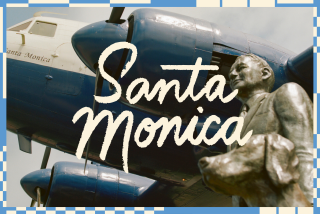Skateboards are a California art form
Artist Raymond Pettibon swathed the blank canvas with a black-and-white image of a woman’s face. The vintage beauty, whose mouth pops with a shade of red lipstick, has four bars -- the signature logo for his brother’s punk rock band Black Flag -- stamped across her face. It’s not a flier for the band. Nor cover art for their record. The image graces a skateboard.
In “Skateboard: Evolution and Art in California,” on view through May, the California Heritage Museum traces the progression of boards from pre-1950 to the present, showcasing the riders, designers, artists and manufacturers who propelled the homegrown activity into a worldwide cultural phenomenon. The location of this exhibit? It couldn’t be better. The museum is in the vortex of “Dog Town,” the Santa Monica/Ocean Park neighborhood that was home to pioneering skateboarders the Z-Boys and where some say modern skateboarding was born. Museum staff curator Michael Trotter curated and designed the exhibition in conjunction with guest curator, Z-boy Nathan Pratt.
More than 300 boards are mounted throughout the space. From a rare Malibu sidewalk surfboard by Champion -- featuring 1960s typography and a surfer on a longboard -- and a red Z-Flex board designed by skateboarding legend Jay Adams to an innovative eight-wheeled deck by skater and board designer Lonnie Toft, the walls are veritable photo album in board form.
“They’re small pieces of sculpture,” said Tobi Smith, executive director of the museum. “They’re like mini paintings. Many artists decided to use skateboards as a showcase for their art. It goes from the scooters to the present. We’re letting the boards tell their story.”
It started with metal roller skate wheels nailed to wooden crates. The boxy devices later simplified into planks of wood. And as surfing became increasingly popular in the late 1950s, the idea to surf the streets became a natural progression. In 1959, the world was introduced to the Roller Derby Skateboard, the first manufactured skateboard. It featured steel wheels, which offered little grip on most riding surfaces.
Once the 1960s rolled around, skateboarding had developed an impressive following. Makaha designed the first professional boards in 1963. Companies such as Jack’s and Hobie soon rolled out with their own sleek and speedy versions.
It wasn’t long before manufacturers were producing boards in bulk, in a variety of materials. There were clay wheels, the cheapest to manufacture. Solid oak planks. Polyurethane wheels. Others had brakes. Some boards even had foot straps, an ancestor to snowboards perhaps? They curved to look like rockets or flared to resemble fish tails.
Whatever the form, riders rode the concrete waves. They slid and skidded down streets and sidewalks. Did jumps and tricks on homemade ramps. “They surfed on concrete,” Trotter said. “They could do trips and spins and turn-arounds. The idea was how to maneuver and what you can do. It stopped being so much about speed and more about the dynamics of it.”
And it also became about the art of it. Collages of stickers adorn some. A few have scrawled marker drawings. Boards of the ‘90s feature Japanese anime figures.
“The way the board looked said a lot about its rider,” Trotter said. “It revealed their personality. They really used the board as a canvas. You’ll see political statements on them, images that express social satire.”
The timeline of skateboards is comprised by boards on loan from Skatelab, South Bay Skates, Santa Barbara Surf Museum and others. The board gallery is supplemented with photographs and art documenting the boards and the personalities who rode them.
The exhibit comes on the heels of a few related exhibits in Huntington Beach, Vancouver, Canada and elsewhere. A full series of events, including talks and autograph sessions, will take place throughout the exhibit run at the museum and the downtown Santa Monica Library.
More to Read
The biggest entertainment stories
Get our big stories about Hollywood, film, television, music, arts, culture and more right in your inbox as soon as they publish.
You may occasionally receive promotional content from the Los Angeles Times.











